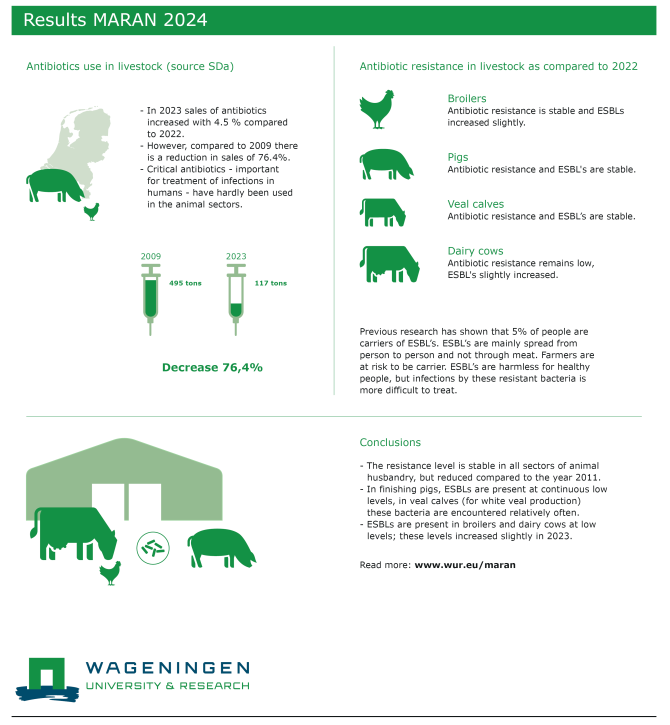Antibiotic usage in Dutch livestock farming has fallen sharply since 2009. The sharp decline in antibiotic usage started levelling of last year, as did the decline in antibiotic resistance in animals. This trend is continuing, according to the latest data on antibiotic resistance in animals presented in the MARAN report 2024.
Wageningen Bioveterinary Research (WBVR) studies the occurrence, spread and prevention of antimicrobial resistance (AMR) in bacteria obtained from livestock. WBVR is leading partner in the yearly MARAN report, which gives an update on the status of antimicrobial resistance in animals in the Netherlands. "The monitoring of AMR in food-producing animals and food is essential to provide reliable information on the development and spread of antibiotic resistance", states WBVR-researcher Kees Veldman, head of the National Reference Laboratory on antimicrobial resistance in animals and key editor of the MARAN report.
Antibiotic usage
In 2023, a total of 117 tonnes of Antimicrobial Veterinary Medicinal Products (AVMPs) were sold, which is an increase of 4.5% compared to 2022. A decrease in sales by 76.4 % over the years 2009-2023 is attained. Based on national conversion factors (DDDAs) of authorized veterinary medicinal products, the calculation of consumption shows that use has stabilized in most sectors. The turkey sector on the other hand, realized a substantial antibiotic usage reduction in 2023.
The use of antibiotics of critical importance to human health care is low, even in the unmonitored sectors.
Antimicrobial resistance
Tracking trends in antibiotic resistance in livestock and food involves analyzing data produced through an annual standardized monitoring program. In practice, this process includes culturing bacteria from faecal or meat samples. Subsequently, antimicrobial susceptibility tests are conducted on indicator bacteria like E. coli and zoonotic bacteria such as Salmonella and Campylobacter.
The susceptibility tests are done using standardized antibiotic panels according to EU legislation. In addition, the collected samples are screened for the presence of bacteria with specific types of resistance that are considered a risk to human health. This includes E. coli exhibiting resistance to 3rd and 4th generation cephalosporins (ESBLs) or resistance to carbapenem antibiotics (CPE).
"Overall, the resistance levels observed in our monitoring program suggest a stabilization of antibiotic resistance in 2023," says Veldman. "Resistance to fluoroquinolones was still commonly present in indicator E. coli from broilers (25.6%) in contrast to the low prevalence observed in pigs (1,7%) and veal calves (4.3%) and the complete absence in dairy cattle." Colistin-resistance remains present at low levels. No CPE was detected in samples from livestock, companion animals or meat.
Detailed information on the antibiotic reduction in animals and animal products is given in the MARAN-report 2024.
Infographic
View the infographic below about antibiotic resistance in livestock animals.

NethMap: antibiotic resistance in humans
Data on antibiotic use and resistance in humans are published annually in NethMap, in collaboration with MARAN. According to NethMap, antibiotic use in hospitals has slightly increased and is now higher than in the years prior to the COVID pandemic, while general practitioners continued to prescribe antibiotics at similar rates as before the pandemic. Additionally, hospitals and nursing homes reported an increased number of outbreaks caused by resistant bacteria, though these numbers remain lower than those observed before the COVID years. Compared to other European countries, antibiotic resistance in humans in the Netherlands remains relatively low.
Although antibiotic resistance in humans remains stable, vigilance against resistant bacteria is still essential. Individuals hospitalized abroad are particularly at risk of carrying bacteria resistant to multiple types of antibiotics. Maintaining hand hygiene and other personal hygiene practices is crucial to prevent the spread of these bacteria. Additionally, minimizing unnecessary and improper antibiotic use is vital.






